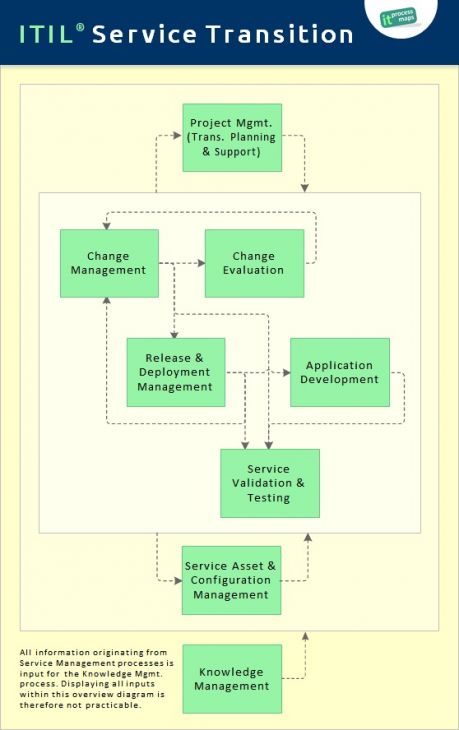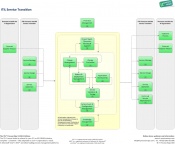ITIL Service Transition: Difference between revisions
No edit summary |
No edit summary |
||
| Line 1: | Line 1: | ||
<itpmch><title>ITIL Service Transition | IT Process Wiki</title> | <itpmch><title>ITIL Service Transition | IT Process Wiki</title> | ||
<meta name="keywords" content="service transition, itil service transition, itil transition, itil v3 transition, itil v3 service transition" /> | <meta name="keywords" content="service transition, itil service transition, itil transition, itil v3 transition, itil v3 service transition" /> | ||
<meta name="description" content="ITIL Service Transition | <meta name="description" content="The objective of ITIL Service Transition is to build and deploy IT services. The Service Transition lifecycle stage also makes sure that changes to services and Service Management processes are carried out in a coordinated way. Part of: IT Service Management | ITIL 2011 processes." /> | ||
<meta property="og:url" content="https://wiki.en.it-processmaps.com/index.php/ITIL_Service_Transition" /> | <meta property="og:url" content="https://wiki.en.it-processmaps.com/index.php/ITIL_Service_Transition" /> | ||
<meta property="og:title" content="ITIL Service Transition | IT Process Wiki" /> | <meta property="og:title" content="ITIL Service Transition | IT Process Wiki" /> | ||
| Line 124: | Line 124: | ||
==Notes== | ==Notes== | ||
<html>By:  Stefan Kempter <a rel="author" href="https:// | <html>By:  Stefan Kempter <a rel="author" href="https://www.linkedin.com/in/stefankempter"><img style="margin:0px 0px 0px 0px;" src="/images/bookmarking/linkedin.png" width="16" height="16" title="By: Stefan Kempter | Profile on LinkedIn" alt="Author: Stefan Kempter, IT Process Maps GbR" /></a>, IT Process Maps.</p> | ||
<p> </p> | <p> </p> | ||
<p><small> | <p><small> | ||
<span itemscope="itemscope | <span itemprop="breadcrumb" itemscope itemtype="http://schema.org/BreadcrumbList"> | ||
<a href="https://wiki.en.it-processmaps.com/index.php/Change_Management | <span itemprop="itemListElement" itemscope itemtype="http://schema.org/ListItem"> | ||
< | <a itemprop="item" href="https://wiki.en.it-processmaps.com/index.php/Change_Management"> | ||
<span itemprop="name">Change Management</span></a> | |||
<a href="https://wiki.en.it-processmaps.com/index.php/Release_and_Deployment_Management | <meta itemprop="position" content="1"></span> › [...] › | ||
</span> | <span itemprop="itemListElement" itemscope itemtype="http://schema.org/ListItem"> | ||
<span | <a itemprop="item" href="https://wiki.en.it-processmaps.com/index.php/Release_and_Deployment_Management"> | ||
<a href="https://wiki.en.it-processmaps.com/index.php/Service_Validation_and_Testing | <span itemprop="name">Release Mgmt.</span></a> | ||
</span> | <meta itemprop="position" content="2"></span> › | ||
<span | <span itemprop="itemListElement" itemscope itemtype="http://schema.org/ListItem"> | ||
<a href="https://wiki.en.it-processmaps.com/index.php/Service_Asset_and_Configuration_Management | <a itemprop="item" href="https://wiki.en.it-processmaps.com/index.php/Service_Validation_and_Testing"> | ||
</span> | <span itemprop="name">Service Validation</span></a> | ||
<span | <meta itemprop="position" content="3"></span> › | ||
<a href="https://wiki.en.it-processmaps.com/index.php/Knowledge_Management | <span itemprop="itemListElement" itemscope itemtype="http://schema.org/ListItem"> | ||
<a itemprop="item" href="https://wiki.en.it-processmaps.com/index.php/Service_Asset_and_Configuration_Management"> | |||
<span itemprop="name">Configuration Mgmt.</span></a> | |||
<meta itemprop="position" content="4"></span> › | |||
<span itemprop="itemListElement" itemscope itemtype="http://schema.org/ListItem"> | |||
<a itemprop="item" href="https://wiki.en.it-processmaps.com/index.php/Knowledge_Management"> | |||
<span itemprop="name">Knowledge Mgmt.</span></a> | |||
<meta itemprop="position" content="5"></span> | |||
</span> | </span> | ||
</small></p> | </small></p> | ||
| Line 156: | Line 163: | ||
<link itemprop="isPartOf" href="https://wiki.en.it-processmaps.com/index.php/ITIL_Processes#ITIL_Processes_according_to_ITIL_2011" /> | <link itemprop="isPartOf" href="https://wiki.en.it-processmaps.com/index.php/ITIL_Processes#ITIL_Processes_according_to_ITIL_2011" /> | ||
<link itemprop="primaryImageOfPage" href="https://wiki.en.it-processmaps.com/images/0/0c/Overview_service_transition_itilv3.jpg" /> | <link itemprop="primaryImageOfPage" href="https://wiki.en.it-processmaps.com/images/0/0c/Overview_service_transition_itilv3.jpg" /> | ||
<link itemprop="author" href="https:// | <link itemprop="author" href="https://www.linkedin.com/in/stefankempter" /> | ||
<meta itemprop="author" content="Stefan Kempter" /> | <meta itemprop="author" content="Stefan Kempter" /> | ||
<meta itemprop="creator copyrightHolder publisher" content="IT Process Maps" /> | <meta itemprop="creator copyrightHolder publisher" content="IT Process Maps" /> | ||
Revision as of 18:16, 27 February 2018


Objective: The objective of ITIL Service Transition is to build and deploy IT services. The Service Transition lifecycle stage also makes sure that changes to services and service management processes are carried out in a coordinated way.
Part of: IT Service Management | ITIL 2011 processes
Processes: ITIL Service Transition

Service Transition builds and deploys new or modified services.
As per ITIL 2011, the following main processes are part of the ITIL stage Service Transition:
- Change Management
- Process Objective: To control the lifecycle of all Changes. The primary objective of Change Management is to enable beneficial Changes to be made, with minimum disruption to IT services.
- Change Evaluation
- Process Objective: To assess major Changes, like the introduction of a new service or a substantial change to an existing service, before those Changes are allowed to proceed to the next phase in their lifecycle.
- Project Management (Transition Planning and Support)
- Process Objective: To plan and coordinate the resources to deploy a major Release within the predicted cost, time and quality estimates.
- Application Development
- Process Objective: To make available applications and systems which provide the required functionality for IT services. This process includes the development and maintenance of custom applications as well as the customization of products from software vendors.
- Release and Deployment Management
- Process Objective: To plan, schedule and control the movement of releases to test and live environments. The primary goal of Release Management is to ensure that the integrity of the live environment is protected and that the correct components are released.
- Service Validation and Testing
- Process Objective: To ensure that deployed Releases and the resulting services meet customer expectations, and to verify that IT operations is able to support the new service.
- Service Asset and Configuration Management
- Process Objective: To maintain information about Configuration Items required to deliver an IT service, including their relationships.
- Knowledge Management
- Process Objective: To gather, analyze, store and share knowledge and information within an organization. The primary purpose of Knowledge Management is to improve efficiency by reducing the need to rediscover knowledge.
KPIs | Templates | Roles
- KPIs for Service Transition
- Service Transition templates and checklists
- ITIL roles within Service Transition
Downloads
|
Use the following links to open the process overview of Service Transition showing the most important interfaces: |
 |
Notes
By: Stefan Kempter ![]() , IT Process Maps.
, IT Process Maps.
Change Management › [...] › Release Mgmt. › Service Validation › Configuration Mgmt. › Knowledge Mgmt.






